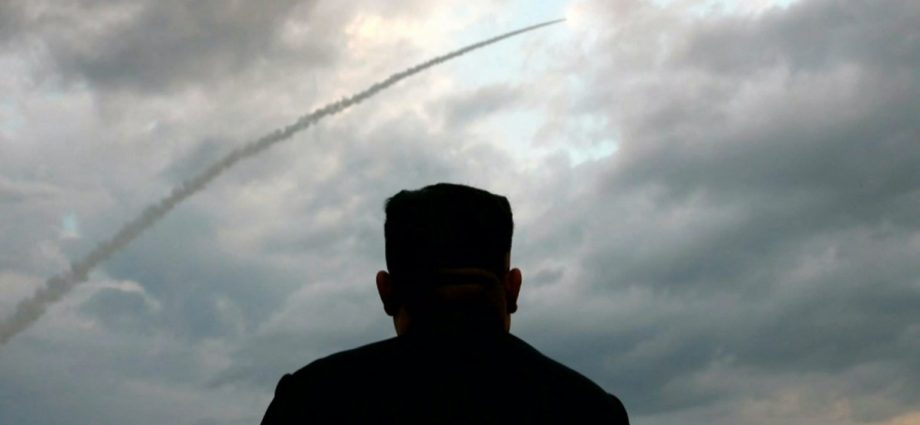Unfazed by US sanctions and military shows of force, North Korea is ramping up its missile program in a spate of blasts that have launched a spy satellite, fired ballistic missiles and tested a solid-fuel rocket motor.
This week, Reuters reported that North Korean state media outlet Korean Central News Agency (KCNA) stated that the country on December 18 conducted “an important, final phase” to develop a spy satellite, which it plans to complete by April 2023.
The report mentions that North Korea conducted its tests at the Sohae satellite launching station to review its satellite imaging, data transmission, and ground control systems. The test involved a launch vehicle carrying a mock satellite, two multi-spectral cameras, image transmitters and a storage battery, the report said.
Reuters mentioned that North Korea fired the mock satellite at a lofted angle and reached an altitude of 500 kilometers. In addition, North Korea released blurred pictures of Seoul and Incheon that it claims were taken from the December 18 launch.
However, some analysts are skeptical about North Korea’s claims, as its statement may again be a cover-up for testing its intercontinental ballistic missile (ICBM) technology.
Reuters says that North Korea’s spy satellite cameras are too weak to provide such imagery and that the test involved an old missile carrying a satellite mockup, which implies the test may have been to validate launch procedures and operational practices, such as sending images back to a ground control station.
This launch may also be a deviation from North Korea’s past practice of disguising missile tests as satellite launches to avoid political and economic consequences.
In line with this analysis, Hwang Ildo writes in a March 2022 article for the Institute for Foreign Affairs and National Security (IFANS) that North Korea chose not to bother disguising its March 24 ICBM test as a satellite launch as it senses weakness in the United Nations Security Council (UNSC) due to Russia’s invasion of Ukraine.

Hwang states that North Korea’s March ICBM test may have been a gamble that paid off considering the UNSC’s lack of a reaction and thus has incentivized Pyongyang to accelerate its missile program.
The fact that North Korea has publicly stated it is preparing a reconnaissance satellite shows that it has military intentions for the launch, which makes any pretense of the planned launch being a national space program project superfluous.
Apart from advancing its missile technology, North Korea may want to rehearse highly-lofted missile launches to increase the chances of penetrating missile defenses. Asia Times has previously noted that highly-lofted trajectory launches result in an extremely high terminal phase velocity, undermining the effectiveness of any missile defense system.
At the same time, the launch trajectory significantly reduces missile range as most of its fuel is expended on reaching a high angle instead of covering great distances.
In such an attack, missile defense radars lose track of the target once it reaches its apex and regains track of the hostile missile too late for interceptors to destroy. Also, as interceptor missiles are flying against gravity, it is harder to catch up, correct course and hit the constantly-accelerating target at the right angle.
Reuters reported last week that North Korea recently tested a high-thrust solid-fuel ICBM rocket engine. This keystone technology enables the development of a solid-fuel ICBM and submarine-launched ballistic missiles (SLBMs), increasing the survivability and flexibility of its nuclear arsenal.
Solid fuel rockets offer a slew of advantages over their liquid fuel counterparts, including a more straightforward design without complex pumps and piping, the lack of need for difficult-to-store and volatile liquid fuels, longer storage life, improved mobility, and no requirement for hours-long pre-flight fueling. Given these advantages, a solid-fuel North Korean ICBM can strike targets in South Korea, Japan or even the mainland US with little to no warning.
The solid fuel engine test came almost right after North Korea fired ballistic missiles into its east coast last week. Reuters reported that South Korea’s Joint Chiefs of Staff (JCS) mentioned two North Korean medium-range ballistic missiles flew 500 kilometers, with Japanese Vice Defense Minister Toshiro Ino saying that the missiles landed outside Japan’s Exclusive Economic Zone (EEZ) and caused no damage.
North Korea is known to use such tests to attract attention to itself amid intensifying global conflicts. This year, the Ukraine war and Taiwan Strait tensions have taken most of the media spotlight. Nevertheless, North Korea may wish to signal that it is still a relevant player in the global arena by through sustained missile firings.

The US and South Korea staged massive military drills in response to Pyongyang’s saber-rattling. The Associated Press reported this week that US B-52 bombers and F-22 stealth fighters, alongside South Korean F-35s and F-15s jets, staged a massive show of force off Jeju Island. The report mentions that the F-22, the most potent fighter in America’s arsenal, has been deployed to South Korea for the first time in four years.
The US and South Korea are also considering staging live fire exercises in 2023, with the last such drills hosted six years ago. Reuters reported that the live-fire drills had been floated during the 70th anniversary of the US-South Korea alliance, wherein both sides discussed ways to deter North Korea.
The Reuters report notes that should these live-fire drills be held, it would end a years-long hiatus of such exercises under former South Korean president Moon Jae-in, who emphasized engagement rather than provocation with North Korea.

